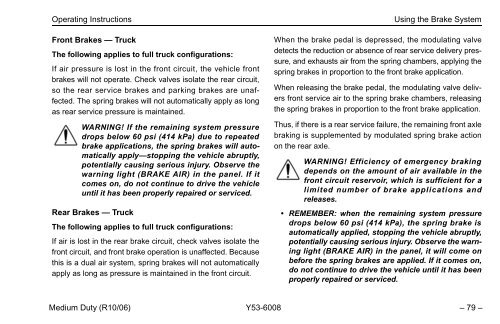Peterbilt Medium Duty Trucks Operator's Manual after 1-07
Peterbilt Medium Duty Trucks Operator's Manual after 1-07
Peterbilt Medium Duty Trucks Operator's Manual after 1-07
Create successful ePaper yourself
Turn your PDF publications into a flip-book with our unique Google optimized e-Paper software.
Operating Instructions<br />
Front Brakes — Truck<br />
The following applies to full truck configurations:<br />
If air pressure is lost in the front circuit, the vehicle front<br />
brakes will not operate. Check valves isolate the rear circuit,<br />
so the rear service brakes and parking brakes are unaffected.<br />
The spring brakes will not automatically apply as long<br />
as rear service pressure is maintained.<br />
WARNING! If the remaining system pressure<br />
drops below 60 psi (414 kPa) due to repeated<br />
brake applications, the spring brakes will automatically<br />
apply—stopping the vehicle abruptly,<br />
potentially causing serious injury. Observe the<br />
warning light (BRAKE AIR) in the panel. If it<br />
comes on, do not continue to drive the vehicle<br />
until it has been properly repaired or serviced.<br />
Rear Brakes — Truck<br />
The following applies to full truck configurations:<br />
If air is lost in the rear brake circuit, check valves isolate the<br />
front circuit, and front brake operation is unaffected. Because<br />
this is a dual air system, spring brakes will not automatically<br />
apply as long as pressure is maintained in the front circuit.<br />
Using the Brake System<br />
When the brake pedal is depressed, the modulating valve<br />
detects the reduction or absence of rear service delivery pressure,<br />
and exhausts air from the spring chambers, applying the<br />
spring brakes in proportion to the front brake application.<br />
When releasing the brake pedal, the modulating valve delivers<br />
front service air to the spring brake chambers, releasing<br />
the spring brakes in proportion to the front brake application.<br />
Thus, if there is a rear service failure, the remaining front axle<br />
braking is supplemented by modulated spring brake action<br />
on the rear axle.<br />
WARNING! Efficiency of emergency braking<br />
depends on the amount of air available in the<br />
front circuit reservoir, which is sufficient for a<br />
limited number of brake applications and<br />
releases.<br />
• REMEMBER: when the remaining system pressure<br />
drops below 60 psi (414 kPa), the spring brake is<br />
automatically applied, stopping the vehicle abruptly,<br />
potentially causing serious injury. Observe the warning<br />
light (BRAKE AIR) in the panel, it will come on<br />
before the spring brakes are applied. If it comes on,<br />
do not continue to drive the vehicle until it has been<br />
properly repaired or serviced.<br />
<strong>Medium</strong> <strong>Duty</strong> (R10/06) Y53-6008 – 79 –
















